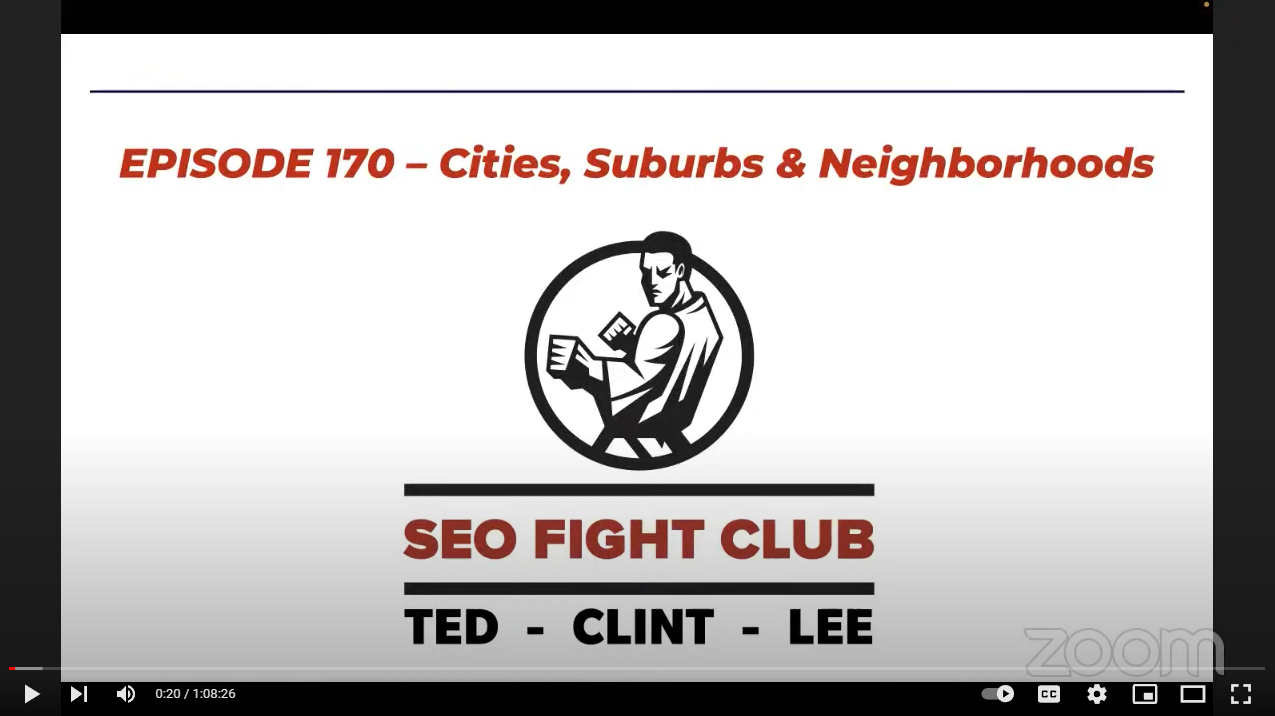SEO Fight Club – Episode 170 – Cities, Suburbs & Neighborhoods
SEO Fight Club / By
Unpacking The Latest SEO Updates: Analyzing Data & Asking Questions.
– Participated in a discussion of an SEO Fight Club episode on data coming out of Cora 7 related to local service areas
– Discussed 10 different factors and four different service areas that can impact SEO
– Aim was to explore, analyze new data and ask questions
– Pragmatic approach suggested to apply the data practically to business needs
– Discussion also around AI content, Google updates, helpful content update and backlinks
– Pointed out that when attributing credit for certain changes seos should have a good plausible explanation
§§ 1000
Summary Talking Points:
– Recently participated in an SEO Fight Club episode discussing more data coming out of Cora 7
– Explored 10 factors impacting SEO within 4 types of service areas
– Objective was to analyze new data and ask questions based on findings
– Proposed taking a pragmatic approach by applying findings directly to businesses needs
– Also discussed topics such as AI content, Google updates, Helpful Content Update & Backlinks with the idea that credit should be attributed only with solid justifications given.
==========
“The Never-Ending Puzzle: How Can SEOs Keep Up With Google’s Changes?”
– The hard question to answer in this space is, until the Laura mipsum sites drop Google still can’t read whether content is helpful or not.
– There could be domain level factors at play besides just the helpfulness of content.
– It’s difficult for SEOs to know what changes they need to make if punitive updates are slow and undetectable.
– It’s possible that people attribute any drops in rankings directly to an update announcement even if it may not be related.
==========
“Trending In Ballard: Uncovering Hidden Opportunities In Suburban Areas”
– People often mistake every illness or sneeze as COVID, but colds still exist.
– Google Trends is an underrated SEO tool for online retail.
– By using Google Trends one can compare the search volume in cities, suburbs and neighborhoods.
– The bulk of search volume is usually found in cities, however, there may be hidden opportunities within suburbs and trendy locations.
– An example of a trend to look out for are residential neighborhoods outperforming suburban searches.
– Ballard is a stylish neighborhood in Seattle which has higher property prices than other areas.
==========
“Ranking The Rivalry: Competing For Search Volume In Neighborhoods And Suburbs”
– I noticed an interesting distinction between popular neighborhoods and suburbs in terms of how they compete with each other when it comes to search volume.
– One factor that affects non-suburb rankings is the amount of keyword stuffing in HTML tags compared to suburbs, which was much higher for Seattle than Ravenna and Ballard.
– The degree of work required changes from neighborhood to suburb; a donut shop in Ballard would be easier to tune for than one in Seattle.
– Working on multiple localities at once requires different amounts of time, resources, and tuning.
==========
“Fine-Tuning Neighborhood SEO For Maximum Results”
– I have found that working on smaller neighborhoods rather than the home page can be beneficial in terms of ranking for primary keywords.
– Breaking into three or four neighborhood keywords first could help to prop up a difficulty breaking into city keyword rankings.
– Measuring entities and understanding Google’s natural language processing provides contextually relevant results.
– Keeping track of which entity correlations are strongest with ranked positions helps to create topical relevance when trying to rank well for certain keywords.
– Comparing search trends between different areas, such as Ballard versus Seattle, revealed interesting opportunities with low levels of tuning competition.
– Variants of key words appearing in sentences is another factor to consider when optimizing SEO efforts
– 60 variants were seen on page 1 in Seattle while 12th were seen in Ballard.
– The number of entities used was also measured, providing further insight into potential opportunities with less competition within specific cities or neighborhoods.
==========
“Unlocking The Potential Of Diversity Factor: Diving Into Traffic Opportunity”
-I learned about a new metric called “diversity factor” which is the ratio of distinct entities used.
-In terms of traffic opportunity, Ballard outranked the suburb despite having fewer overall entities.
-I was surprised to learn about keyword density and how there’s many different ways to calculate it depending on inclusion/exclusion rules.
-Using clean keyword density as an example, we looked at cities with electrician keywords where 3% was required for above average performance.
-The interesting part here is that nobody seems to be competing fiercely on this factor since most SEOs won’t do it!
-We can use Quora to identify if sites are using techniques such as hidden divs or CSS/JavaScript triggers that help explain their performance in specific keyword sets.



